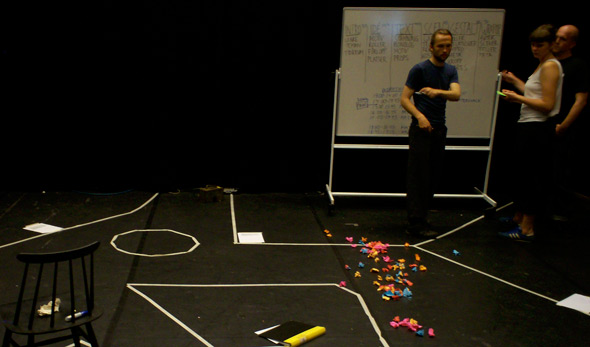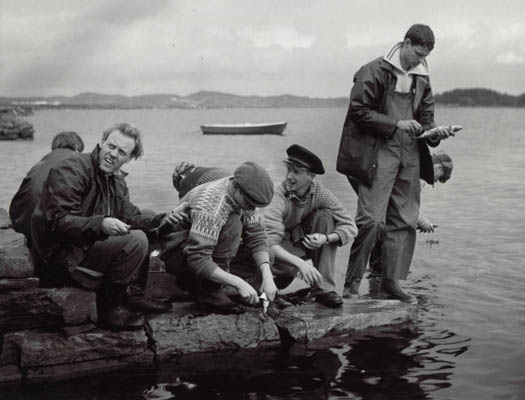The following notes should be useful for people who have attended the Ritual Improv course and want to teach the same techniques to others. It won’t make much sense for those who haven’t.
 Ritual improv at Knutpunkt 2010. Photo: Li Xin
Ritual improv at Knutpunkt 2010. Photo: Li Xin
The following notes should be useful for people who have attended the Ritual Improv course and want to teach the same techniques to others. It won’t make much sense for those who haven’t.
 Ritual improv at Knutpunkt 2010. Photo: Li Xin
Ritual improv at Knutpunkt 2010. Photo: Li Xin
This is larp. It’s improvised. I’ll make mistakes. You’ll make mistakes. You’ll forget parts of the back story. You’ll speak in a voice that’s not appropriate for your character. You’ll mispronounce words that your character knows perfectly. You’ll break a cultural taboo inadvertently. You’ll forget the name of your childhood friend.
And that’s OK. Continue reading Let’s make mistakes together (a pre-larp pep talk)
What is it larp designers actually design? Watch me try to answer this, and other hot-button questions of immediate practical concern in this 45-minute talk I did at Knutpunkt 2014.
Continue reading Elements of Larp Design (video + slides)
Or: why can it be so difficult to achieve a satisfying conclusion to a larp, and what can we do to change that?

Aristotle (Greek philosopher) was the first to describe the structure underlying most dramatic storytelling. It goes like this: Continue reading Dealing with the Aristotelian Curse
Imagine two larps: the first one is about angsty teenagers figuring out the meaning of life in a remote mountain cabin. The second one is exactly the same, except those teenagers are being atacked by zombies. Which larp do you think will attract more players?
In “Talk Larp”, one of the three downloadable anthologies published at the 2011 Knudepunkt conference, Juhana Pettersson’s contribution “The Necessary Zombie” contains two very useful observations:
Continue reading Does your larp have a zombie?
I came across this excellent gathering of advice in Swedish on Gabriel Widings blog, and impulsively translated it into English. Gabriel is one of the authors of the book-slash-provocation deltagarkultur (“participatory culture”) and has spent as much time working with ARGs, collaborative writing and other kinds of participatory culture as he has with larp. So the list below includes but is not limited to the design of live-roleplaying events.
I think it pinpoints precisely how to avoid the mistakes that are usually comitted by people in the Established Arts (theatre, cinema, performance etc.) who try to engage their “audiences” in interactivity or participation, and it also offers up some eternal larpwriting truths. As with most holy text, there is space here for both interpretation and heresy.

By Gabriel Widing
So it’s been a hiatus. My main excuse is that my larp writing energy has gone into a) a larp (Marcellos Kjeller, pics, to be blogged) and b) an article about the larp “1942 – noen å stole på” (FLH, 2000) for the forthcoming Nordic Larp book project. A fiendishly difficult writing project, as the article was to be less than 2000 words. Brevity is not my strong side.

While researching “1942”, a canonical 5-day 130-player larp held on Norway’s west coast back in 2000, I was reminded of the “Three Affiliations” model the 1942 organizers used to provide activities and relationships for their characters. The model was successful enough that it has later been reused for similar Norwegian larps – larps that focus on the living of daily life in smallish communities.
Continue reading 1942 & The Three Affiliations Model
Six couples. A cafè. 3 hours. No orcs, goblins, mystical orders, spies, asassins, or any kind of extraordinary characters. No magic, combat, violence, mystique, politics, or any kind of extraordinary drama. Just regular people, struggling to save or sever their relationships.

It was, of course, a larp – more precisely: Erlend Eidsems “Love in the Age of Debasement”. And the most interesting part of the larp was the innovative way it used written characters to construct the drama.
Continue reading The pre-emptive character – Love in the Age of Debasement

Introducing: the irregular column “Ninja Trick”, presenting clever little larpwriting ideas that are easy to share.
So there’s this group in Elverum in Norway, called “De Krakilske Papegøyer” (DKP), which no-one in the Oslo scene had heard about until they’d already organised five larps. And to the sixth one, Marthe, a larper from Oslo went and returned reporting (no) what she had experienced. Turns out they were using a novel incentive they called “sekundærrolle”, meaning secondary character description: little envelopes that you opened at particular times during the larp.
Continue reading Ninja trick: fate envelopes (and a word on secrecy vs. transparency)
Some eight years ago, I decided to study interactive media – as an undergraduate at Designskolen Kolding and then for a masters degree at Media Lab Helsinki – in order to better comprehend what we did with larp, as well as to find a profession where I might benefit from my experience as a larpwright. The result was disappointing. Continue reading We’re way ahead of you